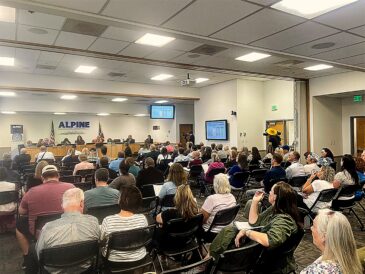Here’s how Nebo School District is approaching new statewide cellphone ban

Harrison Epstein, Daily Herald file photo
The Nebo School District Administration Office in Spanish Fork is shown Friday, April 14, 2023.A bill passed by the Utah Legislature earlier this year banning the use of cellphones in schools will be implemented in classrooms statewide this fall.
Districts, though, are permitted to take some liberties in how the parameters of the law are enforced.
In guidelines set by Nebo School District this summer, elementary school and junior high students each have strict no-phone policies, while high school students are extended a few more privileges.
According to district policy, cellphones and smartwatches in elementary schools are not permitted in school buildings during school hours and must be stowed away with notifications turned off.
If a student needs to communicate with a parent or guardian, the district will allow them to use a cellphone in the front office or counseling office with permission. “Students are only to contact parents or guardians who may be assisting them with a crisis during the school day,” the policy states.
In middle school and junior high, the rules stay the same, with the exception being smartwatches can be worn as long as notifications are turned off.
The guidelines also establish that cellphones may not be taken with students when using a hall pass, unless they’re going to contact a parent or caretaker, and that smartwatches also may not be used.
“Kindergarten through ninth grade … it’s bell to bell,” Nebo spokesperson Seth Sorensen said. “(It’s a) cellphone prohibition policy, so they’re not allowed to use cellphones from the first bell of the day till school gets out.”
For high schoolers, classroom rules are the same, though phone use is permitted in between classes in the hallway and during lunch breaks. According to Sorensen, this access is because high schoolers have more responsibilities to attend to such as sports teams or work.
The rules will be uniform across the district, though Sorensen said individual high schools are permitted to enforce stricter rules, though none have opted to do so yet.
Though the ban is a direct response to the new law, Sorensen said the district has had prior discussions about restricting phone access and said one district school, Landmark High in Spanish Fork, issued a ban last year.
“They tried it out for a year, and it seemed to be working pretty well,” he said. “So I think things were kind of moving in that direction.”
He believes teachers are mostly supportive of the change and said that while it may be a learning curve, it will foster better attentiveness in the classroom.
“We’ve tried to get the word out to parents and students multiple times from multiple sources,” Sorensen said. “We’ve had messages come out from the district itself, and then the schools and teachers are reminding them as well. So it’ll be an ongoing process, I’m sure.
“I think the hope is that without that distraction, students are going to be able to focus more when they’re in classrooms learning, and it will provide additional educational opportunities and additional time for teachers to work with them without those interruptions.”
In the district’s enforcement guidelines for the new rule, schools are granted discretion on how to respond to a violation of policy. Consequences range from the phone getting confiscated and turned into the office for parents to pick up to a possible suspension upon a third violation.



